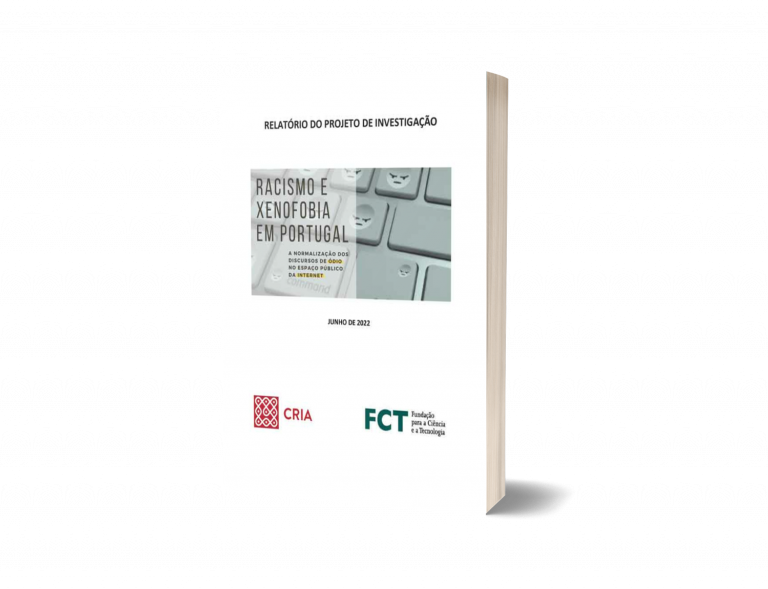RELATÓRIO
Resumo dos resultados do projeto
Análise dos discursos:
A análise comparativa efetuada entre o período pré-pandémico e pandémico revela uma continuidade no que se refere ao conteúdo das próprias narrativas racistas e xenófobas. Desta forma, é o carácter estrutural do racismo na sociedade portuguesa, aliado ao contexto político internacional, que criou as condições necessárias para a banalização dos discursos de ódio. Paralelamente, a predominância da ideologia liberal no contexto europeu, que se refugia na tese da ´liberdade de expressão’, também concorreu para a normalização do racismo online. Neste quadro, os dados recolhidos mostram que os discursos de ódio têm como alvos grupos historicamente marginalizados na sociedade portuguesa, em especial a população negra e a cigana.
População Afrodescendente:
A violência discursiva exercida sobre corpos negros revela a perpetuação da ideologia colonial. Assim, os discursos de ódio analisados apresentam as seguintes particularidades: a) agressividade extrema dirigida aos/às ativistas antirracistas; b) vitimização de quem produz o ódio, numa inversão do ónus, o que se classifica de ‘racismo inverso/reverso’; c) legitimação da violência policial; d) dicotomia ‘civilizado’ versus ‘primitivo’ como justificação para a exclusão de pessoas negras do imaginário nacional.
Comunidade Cigana:
A par do ódio racial dirigido à população negra, a pesquisa deparou-se com um profundo anticiganismo. Assim, os discursos racistas dirigidos às comunidades ciganas encontram-se perfeitamente normalizados em praticamente todos os setores da sociedade portuguesa e são construídos a partir dos seguintes eixos: a) pretensa incompatibilidade cultural e ‘civilizacional’ entre esta comunidade e a sociedade maioritária; b) culpabilização da população cigana pelos episódios racistas reportados pelos media; c) apoio às pretensões de confinamento destas comunidades; d) prevalência do ‘racismo reverso’.
Refugiados e Imigrantes:
Outros dos principais alvos de discursos de ódio racial são as pessoas refugiadas e imigrantes oriundas do continente africano. Percebidas como ‘muçulmanas’, os discursos recolhidos revelam a existência um quadro ideológico marcado por uma islamofobia altamente enraizada. As narrativas contra estas populações apresentam as seguintes características: a) islamofobia abertamente declarada; b) ‘choque de civilizações’, ou seja, incompatibilidade entre o ‘Ocidente’ e o ‘Islão’; c) perigo iminente de ‘islamização’ das sociedades europeias; d) relação íntima entre refugiados e ‘terrorismo’; e) recusa em acolher estas populações.
Inquérito:
Tendo como objetivo o mapeamento acerca do perfil das pessoas que têm sido alvo de discursos de ódio na internet, a equipa do projeto elaborou um inquérito que esteve online e foi respondido por 279 pessoas. Destacamos os principais resultados:
39% dos/as inquiridos/as declararam que já sofreram discursos de ódio na internet, pelo menos uma vez;
Na sua grande maioria são pessoas que se identificam com o género feminino, correspondendo a 62,6% dos/as inquiridos/as, que se situam na faixa etária 36-50 anos;
Quanto à origem/pertença étnico-racial, 27,1% dos participantes declaram-se como portugueses negros e/ou negros de origem africana;
47% dos ataques possuem teor de ódio em relação à origem étnico-racial;
As faixas etárias mais representativas estão situadas entre os 36-50 anos (37,8%), seguindo-se o escalão imediatamente abaixo (26-35 anos), correspondente a 30,2% dos/as inquiridos/as;
77,6% dos/as inquiridos/as refere que os ataques racistas de que foi alvo tiveram impacto na sua saúde mental, nomeadamente ansiedade, sensação de impotência ou fadiga (38,5%) ou desenvolvimento de contra-ataques aos discursos de ódio sofridos (32,9%);
33,6% dos inquiridos denunciou os discursos de ódio decorrentes de interações em plataformas digitais;
74,8% dos inquiridos considera que a pandemia global, gerada pela Covid-19, influenciou a propagação de discursos de ódio no meio digital.
Os veículos com maior incidência de relatos de discursos de ódio são o Facebook (37,3%) e as ‘caixas de comentários’ de jornais nacionais (19%);

